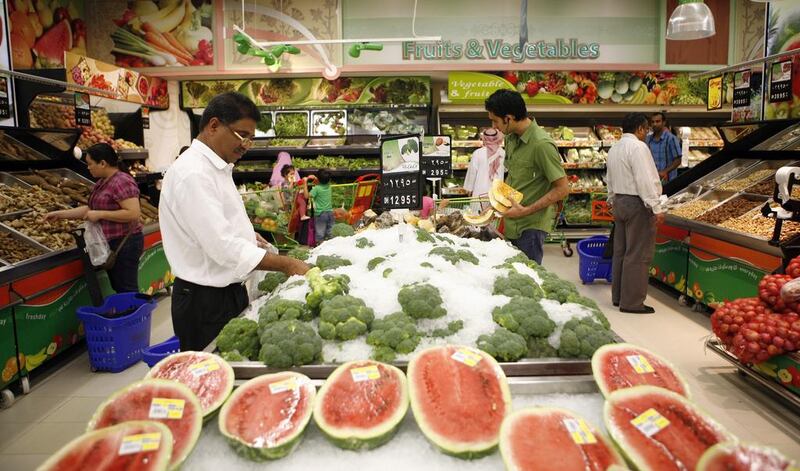Turning a new leaf: As part of The National's Earth Matters coverage, we look at some potential New Year's resolutions for the UAE to help the environment, in a series examining meat consumption, water conservation, food waste and driving habits.
Abu DHabi // Experts have conflicting views on whether eating local UAE produce is sustainable, but one thing is certain – throwing out food waste, whether local or imported, is the biggest issue when it comes to carbon emissions.
Typically, eating food grown closer to home is considered better for the environment because emissions produced by transport and extended periods of refrigeration are lower.
With 95 per cent of food being imported to the UAE, there is a huge environmental cost to eating foreign food.
But the arid environment and heat in the region make growing produce quite energy intensive, because water is used not only for growing but also to keep greenhouse temperatures down.
“In the UAE, water is needed for cooling and the energy used creates challenges. The old-fashioned greenhouses use evaporative cooling to allow us to grow into the summer season,” said Dr Richard Soppe, who works in marginal water management for the International Centre for Biosaline Agriculture. Research has shown that the amount of water used for cooling is actually more than what is used for crop development, he said.
But new science and agricultural technologies developed for the region might make a difference.
“We have to be smart on water use so, for example, we can use saline water for cooling so that we don’t deplete freshwater sources; the value of seawater is significantly less,” Dr Soppe said.
Despite this, developments are being made in the agriculture industry with hydroponics, the process of growing produce without soil that is gaining traction as a resource-efficient method.
“It saves somewhere between 30 and 70 per cent of the water used in the UAE compared with traditional technologies and there is still massive potential to make it even better,” said Yaqoob Al Balooshi, fresh foods purchase manager at the Union Coop. “Telling people that they are being good for the environment by eating local is something we are working on.”
Also good for the environment is eating hydroponically grown food, the most viable alternative growing method given the UAE’s poor soil composition.
A farmer in Sweihan, who wanted to remain anonymous, said that growing hydroponically saved him significantly more water than traditional greenhouse methods.
“Everything is taken into consideration when you have a system, things that you don’t consider when using soil in the UAE with high temperatures – we lose a lot of water because of evaporation,” he said.
Despite conflicting views, however, the best way to save on food emissions is to eat what you buy. Although no statistics are available in the region, the Food and Agriculture Organisation of the United Nations estmates that a third of our food is thrown out.
Beyond the waste, the process goes down to consumer behaviour, said Dr Soppe.
“Changing consumer behaviour, the expectation of perfect produce, if we can change that then we are closer to consumer sustainability. Food waste in general is the biggest problem. When we have guests, we overcook, when we don’t see a perfect cucumber, we don’t choose it,” he said.
Although eating exclusively local is impractical at the moment, some consumers might be surprised to find out that a big part of the environmental cost of eating imported food is incurred during the process of extending its shelf life and not during the transport.
For every vegetable and fruit, there are varying methods of preservation. Apples, for example, undergo an energy-intensive process whereby it is taken through tests before being chilled to just about freezing temperatures for months before sale. The refrigeration is an environmentally costly process.
Regardless of the debate around eating local or imported, the best thing consumers can do today to minimise their food carbon footprint is to buy no more than enough food, to minimise waste.
“Now, consumers have higher expectations and it makes a lot of food waste. So much energy is put in to growing an apple but, because it is not perfect, because it has blemishes, it cannot be sold anymore,” said Dr Soppe. “We need to start changing how we value our food.”
_____
A New Leaf: Green resolutions for 2017:
› Calls to rethink UAE diet as UN study shows environmental damage of eating meat
› Top tips for saving water aim to change attitudes on consumption in the UAE
› Eco-driving important for UAE until public transport serves needs
nalwasmi@thenational.ae





